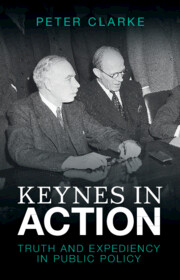Book contents
- Keynes in Action
- Keynes in Action
- Copyright page
- Dedication
- Contents
- Acknowledgements
- Introduction
- 1 What Really Happened at Paris? Keynes and Dulles
- 2 What Really Happened at Paris? The War Guilt Clause
- 3 ‘You Are Very Famous, Maynard’
- 4 The Truth About Lloyd George
- 5 Yielding to Ramsey
- 6 Yielding to Realities
- 7 Truths between Friends
- 8 Truths between Friends
- 9 The Road to Bretton Woods
- Conclusion
- Bibliography
- Biographical Works on Keynes
- Index
1 - What Really Happened at Paris? Keynes and Dulles
Published online by Cambridge University Press: 04 November 2022
- Keynes in Action
- Keynes in Action
- Copyright page
- Dedication
- Contents
- Acknowledgements
- Introduction
- 1 What Really Happened at Paris? Keynes and Dulles
- 2 What Really Happened at Paris? The War Guilt Clause
- 3 ‘You Are Very Famous, Maynard’
- 4 The Truth About Lloyd George
- 5 Yielding to Ramsey
- 6 Yielding to Realities
- 7 Truths between Friends
- 8 Truths between Friends
- 9 The Road to Bretton Woods
- Conclusion
- Bibliography
- Biographical Works on Keynes
- Index
Summary
At the Paris peace conference in 1919, Keynes served as a member of the British delegation. He often represented the Treasury although himself only a temporary civil servant aged thirty-six. But there were equally youthful members of the US delegation with whom he worked closely, initially in support of the position adopted by President Woodrow Wilson in seeking a negotiated peace with Germany. Hence Keynes’s close contact with both Norman Davis and also John Foster Dulles, then a young lawyer. Their task was to define the ‘reparations’ due from Germany under the Armistice agreement – often called the ‘Lansing Note’ after the American Secretary of State, Robert Lansing, who was Dulles’s uncle.
- Type
- Chapter
- Information
- Keynes in ActionTruth and Expediency in Public Policy, pp. 21 - 48Publisher: Cambridge University PressPrint publication year: 2022

